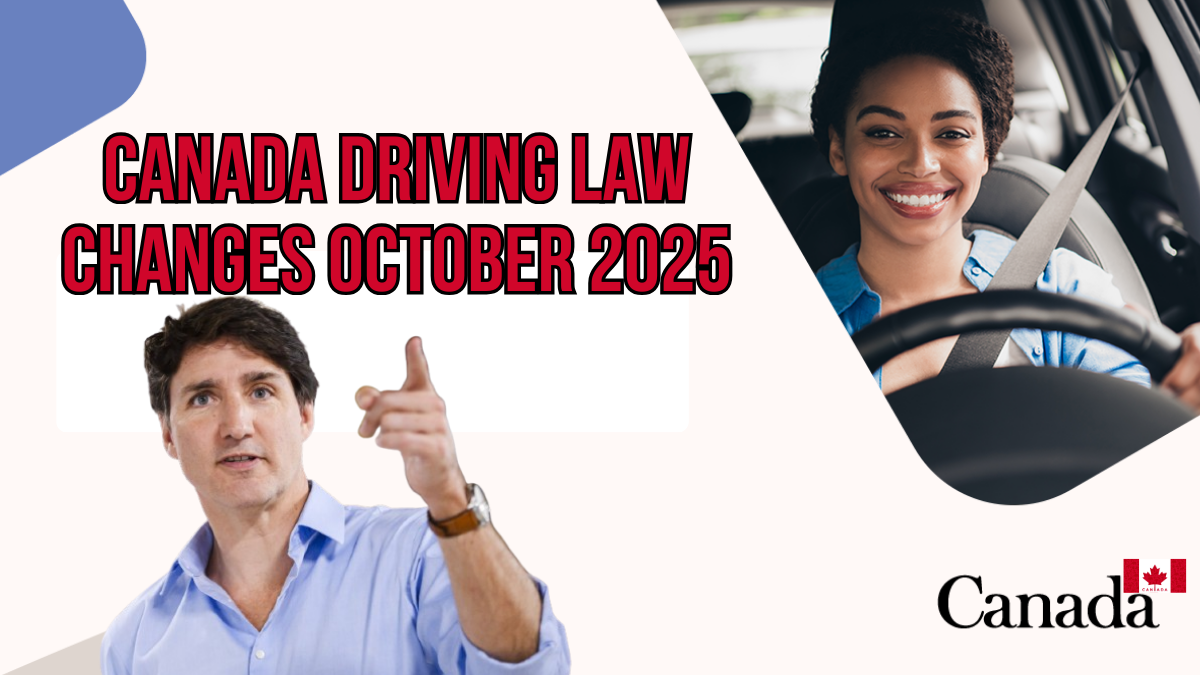The Canadian government has announced a major update to driving laws, effective October 2025, with a focus on stricter penalties, improved road safety, and modernization of traffic enforcement. These reforms are designed to address high accident rates, distracted driving, impaired driving, and inconsistent provincial regulations.

For motorists, the October 2025 Canada Driving Law changes bring higher fines, new demerit thresholds, advanced AI-based enforcement, and stricter compliance checks. Drivers are now expected to adapt quickly, as penalties for even minor infractions have significantly increased.
Why Canada Updated Driving Laws in 2025
The October 2025 reforms are the most comprehensive in recent years. They were introduced after national consultations with provinces, territories, law enforcement, and road safety experts.
Key reasons behind the update include:
- High Accident Rates: Collisions remain one of the top causes of serious injuries and fatalities in Canada.
- Distracted Driving Growth: Phone use while driving has rapidly become a major road hazard.
- Impaired Driving Risks: Cannabis legalization and alcohol-related crashes highlight the need for stricter enforcement.
- Technological Advances: AI cameras and digital monitoring make real-time enforcement possible.
- Standardization Across Provinces: Consistent rules ensure penalties are fair nationwide.
Summary Table of Canada Driving Law Changes (October 2025)
Category |
New Rules / Penalties (Oct 2025) |
|---|---|
Distracted Driving |
$800 fine, 6 points, 90-day suspension for repeat offences |
Speeding |
Up to $2,000 fine; double in school/construction zones |
Impaired Driving |
$2,500 fine + 1-year suspension (first offence) |
Seatbelt/Child Restraint |
$600 fine; mandatory child safety restraints under 12 |
License Demerit System |
Suspension at 6 points (novice), 12 points (full license) |
Parking Violations |
25% increase in major cities |
Emergency Lane Blocking |
Up to $1,500 fine |
Enforcement Technology |
AI cameras, ANPR, digital ticketing, real-time checks |
Key Driving Law Changes
Stricter Distracted Driving Rules
- Fines for texting or holding a mobile phone increased to $800 CAD.
- 6 demerit points added for each offence.
- Repeat offenders face a 90-day license suspension.
Speeding Penalties Expanded
- Excessive speeding (40 km/h over the limit) now carries fines up to $2,000 CAD.
- Double penalties in school zones and construction areas.
- Repeat violators may be forced to attend mandatory retraining programs.
Impaired Driving Crackdown
- Legal BAC limit remains 0.08, but punishments are tougher.
- First-time offenders: $2,500 fine + 1-year license suspension.
- Drug-impaired drivers face identical penalties under cannabis laws.
Seatbelt and Child Restraint Laws
- Seatbelt violations now cost $600 CAD.
- Children under 12 years must use age-appropriate restraints.
- Police empowered to conduct stricter roadside checks.
License Renewal & Demerit System
- Digital license renewals available nationwide.
- Demerit thresholds lowered:
- Novice drivers: suspension at 6 points.
- Full license holders: suspension at 12 points.
Parking & Traffic Violations
- Illegal parking fines in major cities increased by 25%.
- Blocking emergency lanes can cost up to $1,500 CAD.
Enforcement Technology in 2025
The reforms introduce AI-powered tools for real-time enforcement:
- AI Traffic Cameras: Detect speeding, phone use, and red-light jumping.
- Automatic Number Plate Recognition (ANPR): Flags uninsured or unlicensed vehicles.
- Real-Time Database Access: Police can instantly check license validity.
- Digital Ticketing: Tickets sent directly to drivers’ online accounts.
Impact on Motorists
The law changes affect both casual and professional drivers:
- Higher Fines: Even minor infractions carry heavy costs.
- Quicker Suspensions: Lower demerit limits increase risk of losing licenses.
- Professional Drivers at Risk: Truck, taxi, and delivery drivers face tighter scrutiny.
- Insurance Premiums: Violations now directly increase insurance rates.
Benefits of the New Laws
Despite their strictness, the laws bring positive outcomes:
- Safer Roads: Anticipated decline in crashes and fatalities.
- Fairer System: Nationwide standardization reduces confusion.
- Improved Enforcement: AI reduces bribery and manual errors.
- Responsible Driving Culture: Strong deterrents encourage safe practices.
Public Concerns and Criticism
While many support the reforms, concerns remain:
- Affordability of Fines: Low-income drivers may struggle with penalties.
- Privacy Issues: AI surveillance raises civil liberty questions.
- Senior Drivers: Tougher renewal rules may disproportionately affect older Canadians.
- Rural Challenges: Areas with limited transport alternatives fear unfair targeting.
Tips for Drivers to Stay Compliant
- Always obey speed limits, especially in school or construction zones.
- Use hands-free devices responsibly, and avoid unnecessary phone use.
- Plan ahead to avoid driving under the influence of alcohol or cannabis.
- Check license status and track demerit points regularly.
- Stay informed about provincial updates, as enforcement may vary.
FAQs
Q. What is the fine for distracted driving in October 2025?
A. The fine is $800 CAD with 6 demerit points. Repeat offenders risk a 90-day suspension.
Q. How have speeding penalties changed?
A. Excessive speeding now costs up to $2,000 CAD, with double penalties in school and construction zones.
Q. What are the penalties for impaired driving in 2025?
A. First-time offenders face a $2,500 fine and a one-year license suspension.
Q. How many demerit points cause a suspension now?
A. Novice drivers: 6 points. Full license holders: 12 points.
Q. Will AI cameras issue tickets automatically?
A. Yes, AI-powered traffic cameras will issue digital tickets for violations.
Conclusion
The Canada Driving Law October 2025 update represents a turning point for road safety. By combining stricter fines, lower demerit thresholds, and advanced AI-based monitoring, the government aims to save lives and reduce traffic accidents.
While the penalties may feel tough, they are intended to encourage safer driving habits and create a fair, standardized system nationwide. Drivers should adapt quickly to avoid penalties and contribute to safer roads across Canada.
For More Information Click HERE




